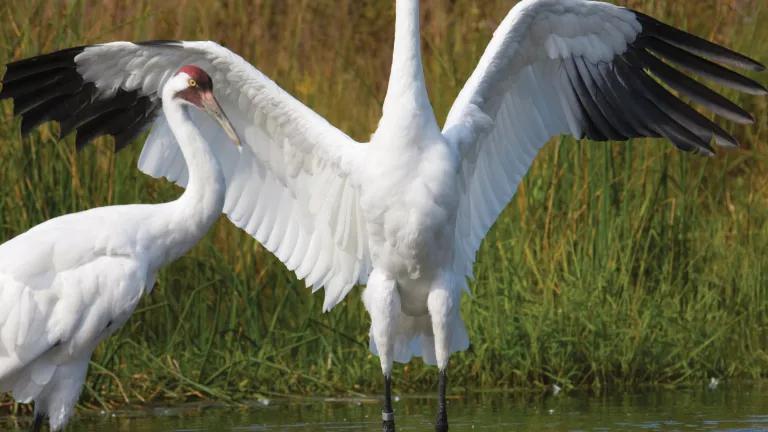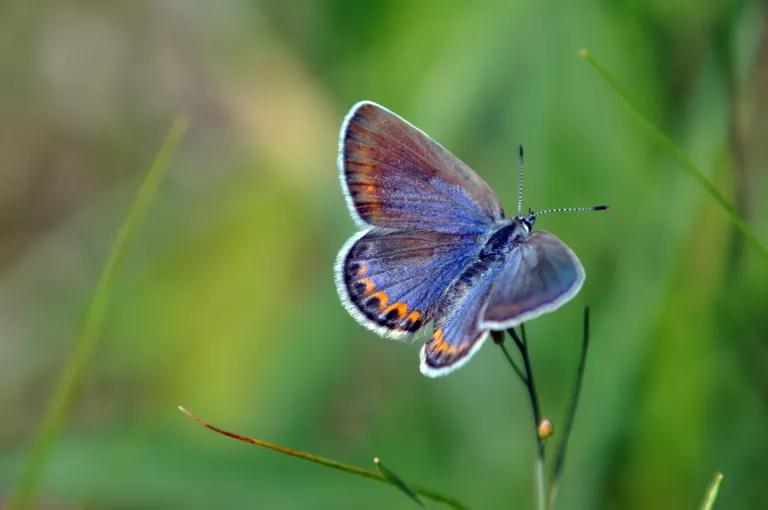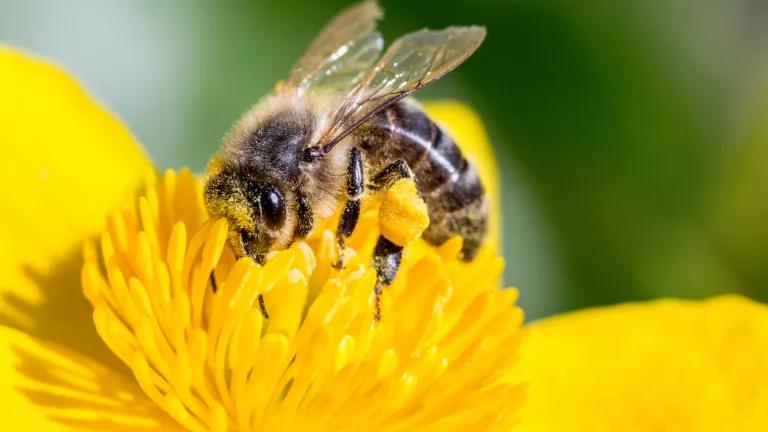EPA: Neonic Likely Harms Nearly 80% of Listed Species
The U.S. Environmental Protection Agency has found that 1,445 endangered and threatened species are likely harmed by imidacloprid, a pesticide commonly used throughout the nation.

Critically endangered whooping cranes are among the species likely to be harmed by imidacloprid.
EPA's draft biological evaluation serves as a stark reminder of the effects of neonic use on wildlife. It also highlights the importance of ESA consultation on pesticide approvals.
Update: EPA has finalized its biological evaluation for imidacloprid, confirming its earlier conclusion that the pesticide likely harms 1,445 endangered and threatened species. The U.S. Fish and Wildlife Service and National Marine Fisheries Service now must determine whether imidacloprid is likely to jeopardize those species or adversely modify their critical habitat. That determination could result in significant new restrictions on use of imidacloprid.
The U.S. Environmental Protection Agency (EPA) announced that one of the most widely used neonicotinoid insecticides in the country, imidacloprid, is likely to harm 1,445 endangered and threatened species. The agency’s analysis, prompted by an NRDC lawsuit, confirms that widespread neonic use presents serious risks to ecosystems and presents EPA with a crucial opportunity to rein in their use. Here are three things to know about EPA’s analysis.
EPA’s Analysis Is Long Overdue
The Endangered Species Act (ESA) is the country’s most important and successful wildlife conservation law. One of the central components of this law is a process called “interagency consultation,” which requires all federal agencies to ensure that their actions do not jeopardize the continued existence of threatened and endangered species. Agencies are required to complete this process before they take an action that may affect listed species.
EPA must register all pesticides before they can be sold and used, and this registration triggers the requirement to engage in consultation under the ESA. But for decades, EPA has approved pesticides while ignoring the consultation requirement, turning a blind eye to the impacts that these chemicals have on imperiled species.
Imidacloprid is a good example. EPA first registered pesticide products containing imidacloprid in the mid-1990s—nearly thirty years ago—meaning EPA should have completed the consultation process then. Instead, it continued to register additional imidacloprid products for years, making it one of the most commonly used insecticides in the country, with no regard for the ESA’s mandate.
EPA continued to ignore the consultation requirement for imidacloprid products until NRDC sued in 2017 to force the agency to act. In 2020, NRDC and EPA reached a settlement which required EPA to issue a “biological evaluation”—the first step in the consultation process— by July 2022. Without this lawsuit and settlement, it is likely that EPA would have waited significantly longer to begin this process.
The agency’s recent announcement is a draft biological evaluation, the first step toward compliance with NRDC’s settlement and long overdue compliance with the ESA. While this evaluation does not require restrictions on imidacloprid’s use, it lays the groundwork for a consultation process that could result in important restrictions. And its conclusions serve as a stark reminder that we must act to curb neonic use.

The Karner Blue Butterfly is another endangered species likely harmed by imidacloprid use.
Neonics Are Disastrous for Listed Species and Their Habitat
Imidacloprid and other neonicotinoid insecticides, or “neonics,” are neurotoxic pesticides designed to target and destroy the insect nervous system. Since their introduction in the mid-1990s, neonics have become the most widely used class of insecticides in the world. Research now identifies their widespread use as a leading cause of bee declines and links their use with the ongoing disappearance of birds and the collapse of aquatic ecosystems. Not only are neonics toxic to a range of species, but they indiscriminately kill insects and other species that serve as prey for mammals, birds, fish, and others.
With this in mind, EPA’s finding that imidacloprid use is likely to harm nearly 80 percent of endangered and threatened species is no surprise. Species likely to be impacted include 69 mammals, 77 birds, 175 fish, 133 insects and other terrestrial invertebrates, and 884 plants. Imidacloprid is also likely to adversely affect the habitat of 658 species—83 percent of the habitats analyzed. Clearly, its use harms far more than just insects.
EPA also released draft biological evaluations for two other neonics, pursuant to a settlement with the Center for Biological Diversity: thiamethoxam and clothianidin. EPA found that these pesticides, used heavily in agriculture, are likely to adversely affect 1,396 and 1,225 species, respectively.
The agency’s draft biological evaluations for these three pesticides confirm what we already knew: that widespread use of neonics has devastating consequences for wildlife and contributes to the ongoing biodiversity crisis that we are facing. Now, EPA must use this information to crack down on neonic pollution that is rampant across the nation—for the good of wildlife and our own health.

That's right- even grizzly bears are likely to be harmed by imidacloprid use, according to EPA.
Consultation is One Possible Solution to a Broader Problem
While EPA has released biological evaluations for a tiny proportion of the hundreds of pesticides in use across the nation, these analyses tell a consistent story: ubiquitous and often unnecessary pesticide use is destroying ecosystems. Insecticides like neonics are not the only problem. Glyphosate, an herbicide commonly known as RoundUp, is used on about 300 million acres of agriculture each year. EPA’s draft biological evaluation found that its use likely harms 1,676 endangered and threatened species—or a staggering 93% of listed species.
As my colleague and I have written about previously, EPA’s pesticide review process is biased in favor of approval, meaning EPA has made little effort to address this crisis. That absolutely must change. But EPA’s wildly delayed consultation process for these pesticides may provide a new basis to rein in their use to protect the many imperiled species that Americans cherish. As the consultation process moves forward, EPA must seize on that opportunity.




